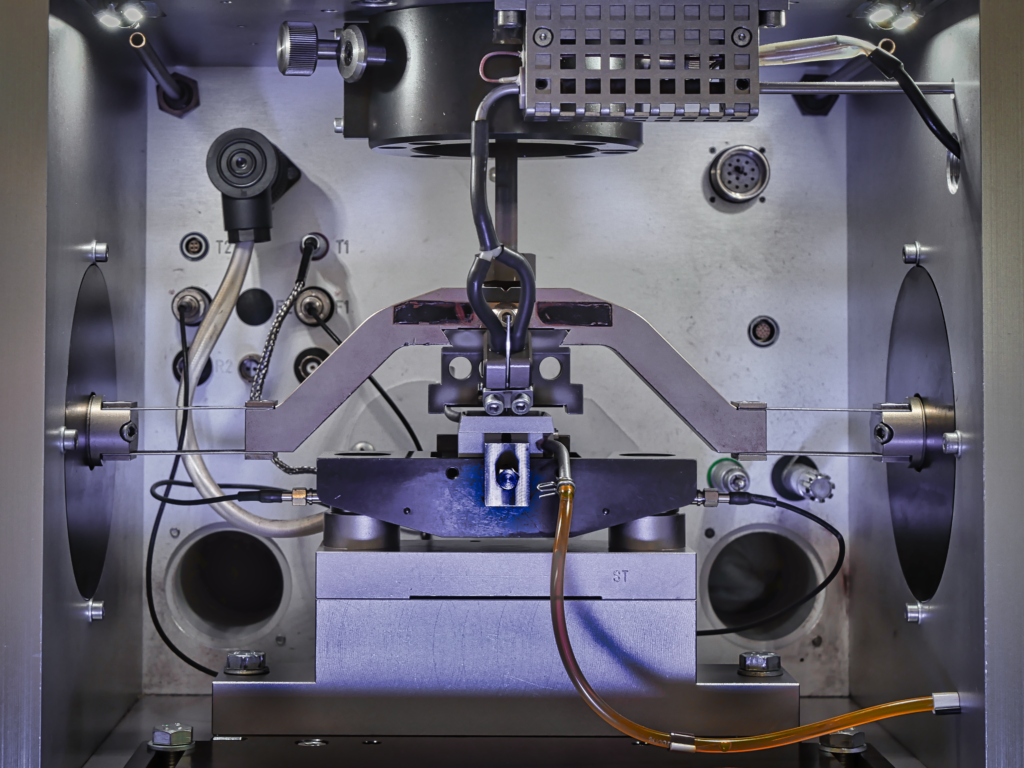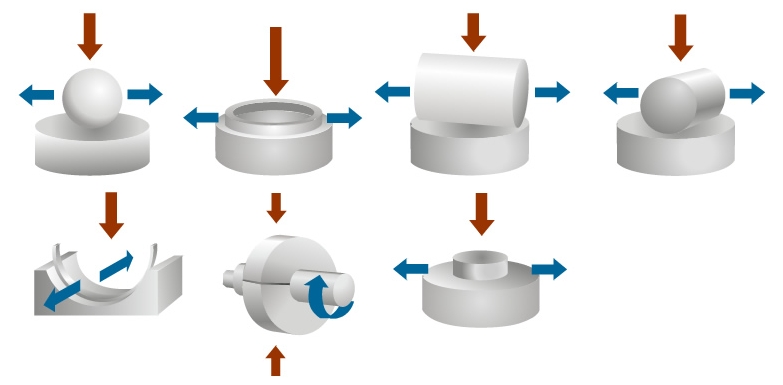High-Frequency, Linear-Oscillation Test Machine (SRV)

Originally, the device was mainly used to study the friction wear that occurs as a result of vibrations of very small amplitude and high frequency.
Today, the instrument standardized in DIN 51 834 is frequently used for basic characterization of oils and greases (EP and AW behavior). In addition, it is also used to simulate longer oscillating sliding motions, such as in the piston/cylinder pairing.
| In the model test, a transverse steel cylindrical roller, a steel ring standing vertically on it or a steel ball is oscillated against a fixed steel plate on the face. Lubricating oils, greases, pastes, dispersions and dry lubricating films can be run at various loads in continuous operation or until the lubricating film breaks down. The purpose is to determine the effect, load capacity and service life of lubricants and their additives during oscillating movements. Another field of application is the investigation of materials and surface layers. This can be done dry or lubricated. | |||||||||||||||||||||||||||||
| The advantage is that only very small quantities of lubricant are required for the tests on the SRV tribometer, the load can be adjusted in a variety of ways and numerous measured variables can be recorded with high precision. | |||||||||||||||||||||||||||||
| The equipment available at KTM also allows complex dynamic test programs to be carried out. In addition, spatially and temporally resolved stroke and friction signal analysis is possible using the FSA module or High Resolution Signal Analysis (HRA). | |||||||||||||||||||||||||||||
| Contact resistance and accoustic emission measurements are also possible on individual devices. | |||||||||||||||||||||||||||||
|
|||||||||||||||||||||||||||||
| High Resolution Signal Analysis (HRA) Spatially and time resolved stroke and friction signal analysis, displayed on 1 period each Prepared for additional options such as resistance, noise measurement, wear |
|||||||||||||||||||||||||||||
|
Standard tests DIN
- Determination of friction and wear parameters for lubricating oils; DIN 51834-2; ASTM D6425-05
- Determination of the tribological behavior of materials in interaction with lubricants; E DIN 51834-3
- Testing the tribological serviceability of transmission/hydraulic fluids, E DIN 51834-4:
- Tribological testing of bonded dry lubricants on the translational oscillation tester; E DIN 51834-8
- Determination of friction and wear parameters for grease-lubricated plastic sliding couples; E DIN 51834-9
- Textile machinery and accessories – Needle and sinker lubricating oils for knitting machines – Part 1: Minimum requirements for mineral oil based oils; DIN 62136-1
- Diesel fuel method for the determination of lubricity using a vibration wear tester; DIN ISO 12156-1
Tests according to international standards
- ASTM D 5706-05 and E DIN 51834-5: Standard Test Method for Measuring Friction and Wear Properties of Lubricating Greases Using A High-Frequency, Linear-Oscillation (SRV) Test Machine (EP Properties of Greases)
- MASTM D 5707-05 and E DIN 51834-6: Standard Test Method for Determining Extreme Pressure Properties of Lubricating Greases Using A High-Frequency, Linear-Oscillation (SRV) Test Machine (Friction and Wear Properties of Greases)
- ASTM D7217-05: Standard Test Method for Determining Extreme Pressure Properties of Solid Bonded Films Using a High-Fequency, Linear-Oscillation (SRV) Test Machine
- Wear Preventive Characteristics of Lubricating Grease; ASTM D 2266-86
- ASTM D7421-08: Standard Test Method for Determining Extreme Pressure Properties of Lubricating Oils Using a High-Fequency, Linear-Oscillation (SRV) Test Machine
- ASTM Working Group 15940: Standard Test Method for Determining Tribomechanical Properties of Grease Lubricated Plastic Socket Suspension Joints Using a High-Fequency, Linear-Oscillation (SRV) Test Machine
- Vibration friction wear test for lubricants (SRV) according to TRW in-house standard for cardan shaft greases (plastic joints) (TRW 62051301)
- EN 1071: Reciprocating Wear Test for Ceramic Coatings [CEN/TC 184/WG5 Document N148)
- ASTM-Working Group: Standard Test Method for Tribological Characterisation of Piston Ring and Cylinder Liner Materials and Lubricants using SRV Test Machine
- ASTM Working Group: Measuring Fretting Wear and Resistance of Lubricating Grease under High Hertzian Contact Pressures Using a SRV Test Machine
- ISO 19291:2016, Testing of lubricants – Tribological testing in a translational oscillatory tester – Determination of tribological properties of oils and greases in a translational oscillatory tester.
Possible specimen geometries

